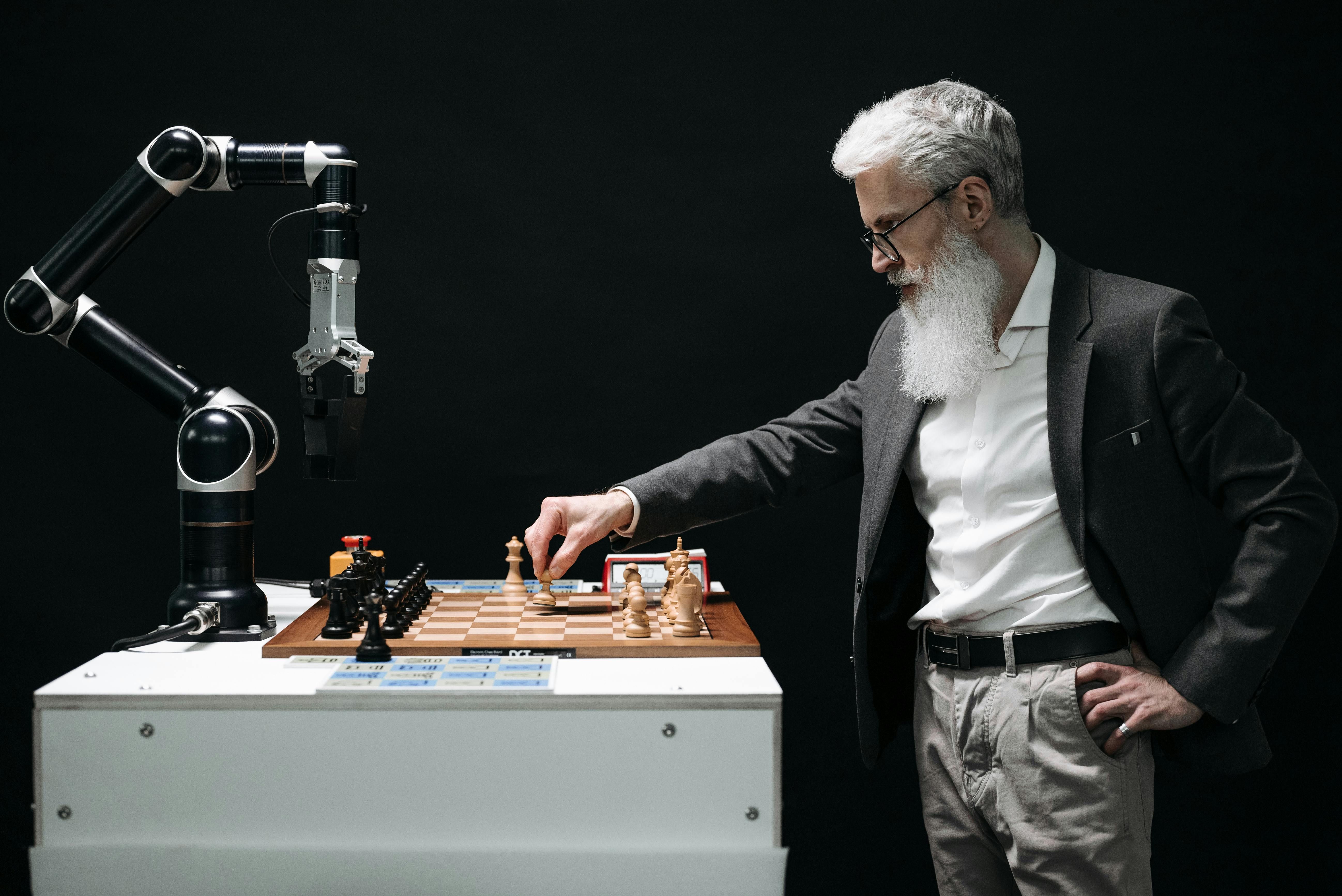It was supposed to be simple. A quick blog integration for a client’s website. I thought to myself, “This is a perfect job for an AI. I’ll just ask Google Gemini, Claude, and ChatGPT to whip this up for me.” By the way, I run Hillside Web Design, a web development company that prides itself on lightning-fast, pixel-perfect websites. I know my craft. But in that moment, I craved a shortcut. I thought I could delegate a complex task to an algorithm and save a few hours.
Four hours later, I found myself in a remarkably… no, unspeakably painful process, arguing with three different Large Language Models (LLMs). The simple task had morphed into a frustrating, demoralizing battle against broken code, irrelevant suggestions, and my own mounting ignorance. It was a stark reminder that in the age of AI, deep, specialized knowledge isn’t just valuable - it’s irreplaceable. This is the story of my AI-induced headache and the lesson it reinforced: AI is a tool, but true artistry comes from human expertise.
The Allure of the Quick Fix: My Four-Hour War with an AI
My goal was to implement a blog for an up-and-coming author using Astro, a framework I love for its performance, and Decap CMS for content management. Since Astro is a content-centric framework with lots of integration options, I figured it would be a breeze. Instead of diving into the documentation, I turned to AI, hoping for a copy-paste solution.
That is not what happened. What actually unfolded was a rapid descent into digital hopelessness. I spent the next several hours sending what felt like hundreds of prompts to the world’s most advanced AI models.
The initial results were deceptively promising. Claude, for instance, did a surprisingly good job styling the blog’s front end. It wasn’t perfect - the hover transitions were clunky - but it looked great. The real nightmare began with the back-end integration. The core of the problem was user authentication. I needed a simple way for the author to log in with a username and password to write and manage their posts.
This is where the AI’s lack of genuine understanding became glaringly obvious. I was working with multiple, interconnected systems:
- Astro: The website framework.
- Decap CMS (formerly Netlify CMS): The content management interface.
- Netlify Identity: The service for user authentication.
I knew very little about how these pieces were supposed to talk to each other, especially concerning Astro’s dynamic rendering and Netlify’s authentication protocols. I was going in blind, and I had hired an equally blind guide - the AI.
The Downward Spiral: When AI-Generated Code Creates Chaos
The AI models confidently gave me sleek code snippets to use in my project. I would paste them into files like config.ts, which handles the Astro side of the blog, or admin/config.yaml, which configures the Decap CMS interface. The problem was, I didn’t actually understand what those files did, or the part they played in the larger story. I honestly couldn’t have told you that config.ts was related to Astro, or that admin/config.yaml was for Decap. It was all a blur of filepaths and code garbage.
Frankly, I was just a passenger on a ship steered by an algorithm, and the ship was spinning aimlessly in the middle of the ocean. No course, no objective… Okay maybe I am being too dramatic. To explain a bit more of the horror, here’s a glimpse into the frustrating loop:
- The Problem: The login screen would appear, but there was no option for a new user to register with a username and password. It only offered a username+password login, which was useless for my client who had yet to sign up.
- The AI “Solution”: The AI suggested I manually invite the user from the Netlify dashboard. So, I sent an invite to a test email.
- The New Problem: I’d click the invite link in the email, and it would take me back to the same login screen with no way to set a password. Trying to invent a password from that screen resulted in a vague error.
- The Next AI “Solution”: “The problem is your script tags,” one LLM insisted. “You need to put this specific script tag at the bottom of your index page.” I moved the script tags around. I manipulated URLs. I deleted users and resent authentication emails in an endless cycle. To no avail.
To make matters worse, I wasn’t sure if the changes would only work on the live server or not. My development process devolved into a chaotic series of git push, git push, git push, sending potentially broken code straight to the staging site. This is a cardinal sin in professional web development, but I was desperate.
Every proposed solution felt like a shot in the dark. With each failure, the AI would generate a new fix, but that “fix” would inevitably break another part of the integration. I felt completely skill-capped, not by my own limitations, but by the AI’s. Every solution it gave me, I got more hopeless because it caused another problem that I didn’t know how to fix. I didn’t know how the pieces work together so I couldn’t debug on my own. I felt dumb, demoralized, and utterly stuck. I got a working solution at the end of the work day, and it hardly felt like a victory. It felt more like surrender. Maybe I am over exaggerating for the purpose of the blog post, but believe me when I say this - I was simply done with what AI could offer.
A Different Approach: Why Reading the Manual Was Faster and More Rewarding
The next day, still smarting from my experience, I decided to tackle a similar project: adding a blog to my own company’s website, hillsidewebdesign.com. This time, I made a different choice. I resisted the urge to open a new tab for ChatGPT. Instead, I opened the documentation.
I walked through the official setup guides for Astro and Decap CMS, step by step. It felt slower at first. There were no instant answers, no magic code snippets. But a remarkable thing happened: I started to understand.
The frustration didn’t vanish entirely - coding always involves a bit of head-scratching. I ran into new issues, like figuring out the correct file paths for media uploads. But the nature of the frustration was different. Yesterday, I was on the AI’s sinking ship - helpless. Today, I was surfing the waves on my own little surfboard. I was in control.
When I got stuck, I knew what I was stuck on. I could form a specific, intelligent question. I did use an AI, but strategically. I would ask, “Hey, can you find me the link to the documentation that talks about this specific type of dynamic page rendering in Astro?” The AI would provide the link, I’d click it, and then I’d close the AI tab to do the reading myself.
The result? I not only integrated the blog successfully and in less time than I’d wasted the previous day, but I also gained genuine knowledge.
- I learned how Astro’s configuration interacts with the CMS.
- I discovered a much simpler authentication workflow: keep the registration set to “open,” sign myself in with GitHub, and then switch it back to “invite-only” to keep it secure. It was a simple, elegant solution my brain devised because it was actually engaged in problem-solving, not just copying and pasting.
- I felt capable again. The feeling of being dumb was replaced by a sense of accomplishment and growth.
The experience clarified a core belief we hold at Hillside Web Design: the value of specialization in the age of AI is higher than ever.
The Case for Deep Specialization in an Age of AI
My struggle highlights a critical flaw in relying on generalized AI for specialized tasks. An LLM can scrape billions of data points and regurgitate code patterns, but it lacks true comprehension. My implementation of AI didn’t understand the why behind the code. It couldn’t see the architectural big picture or anticipate how a change in one file will cascade into a system-breaking error in another. Maybe I was just using the wrong AI tool… but I’ve heard similar whisperings from engineers who are better at building software than I am.
This is where subject matter expertise becomes a superpower. A specialist - a true web design expert - offers value that an AI cannot replicate:
- Architectural Understanding: An expert knows how the framework, the CMS, the hosting environment, and the authentication layer all function as a cohesive system. This holistic view is essential for building robust, secure, and scalable websites.
- Efficient Debugging: When something breaks, an expert doesn’t just guess. They know where to look. They understand the error messages and can trace the problem to its source, saving hours of frustrating trial and error.
- Future-Proofing and Best Practices: AI models are often trained on outdated data. In my case, I suspected the AI was suggesting solutions for deprecated features. An expert stays current with industry best practices, ensuring your website is built on a modern, updated foundation. To learn more about how we do this in our custom website development, I’d love to chat more about our process. Call or email any time!
- Security and Performance: A generic AI solution can easily introduce security vulnerabilities or performance bottlenecks. Hillside’s focus on static-site architecture and pixel-perfect layouts is a deliberate choice rooted in deep expertise, designed to deliver secure, search-friendly experiences that an algorithm may not be able to guarantee.
Relying too heavily on AI makes you a worse developer over time. It erodes your problem-solving skills and caps your potential at the level of the machine. The depression you feel when you’re blocked by an AI is far worse than the frustration of a personal skill issue, because at least when you have a skill issue, you can learn and grow.
How Our Expert Web Design Company Puts Specialization into Practice
At Hillside Web Design, the story I’ve shared is more than just an anecdote; it’s the foundation of our entire business model. We don’t offer generic, someone-else-wrote-this code. We provide deep, hand-written specialization.
When you work with us, you’re not hiring a prompt engineer. You’re hiring dedicated experts who have put in the hours to master their craft. We’ve read the documentation, we’ve navigated the frustrating bugs, and we’ve emerged with the knowledge to build websites the right way.
Our commitment to a specific tech stack - Astro, Tailwind CSS, and static-site generation - isn’t a limitation; it’s a strength. It allows us to build with unparalleled speed, security, and precision. We handle everything from custom design and domain management to hosting and unlimited edits because we understand the entire ecosystem.
Conclusion: Choose Expertise Over Algorithms
My four-hour struggle with AI was a powerful lesson. While AI is an incredible tool for brainstorming, summarizing, and handling isolated, repetitive tasks, it is not a craftsman. It cannot replace the nuanced understanding, creative problem-solving, and architectural foresight of a dedicated specialist. Over-reliance on it is a trap that stunts growth and leads to mediocre results.
At Hillside Web Design, we believe in a better way. We combine the best of modern tooling with old-fashioned expertise. We do the hard work of learning and specializing so you don’t have to worry about AI glitches, broken features, or security holes. We build lightning-fast, mobile-first websites that inspire confidence and drive qualified traffic, all backed by a 100% satisfaction guarantee.
If you’re ready to focus on your business while a dedicated expert handles your web presence, then I’d love to talk. Just contact me and we can build something exceptional together. Otherwise, I hope you at least enjoyed my embarrassing story…

